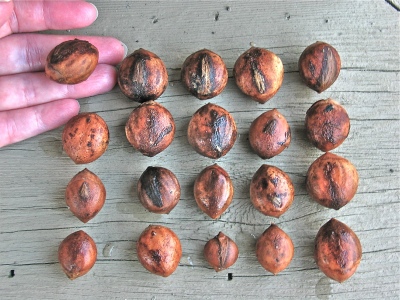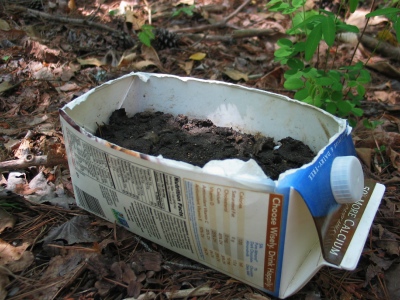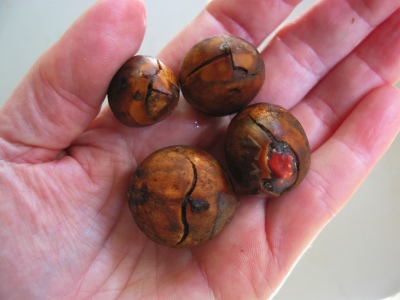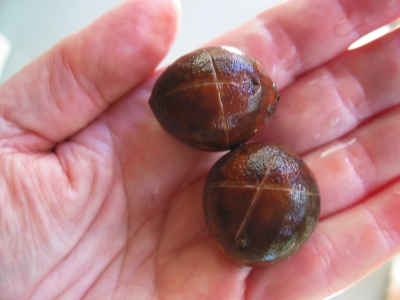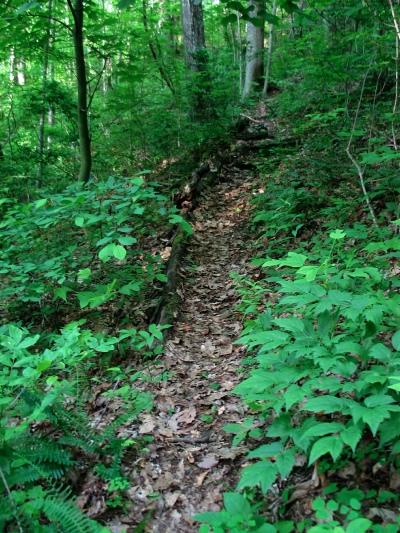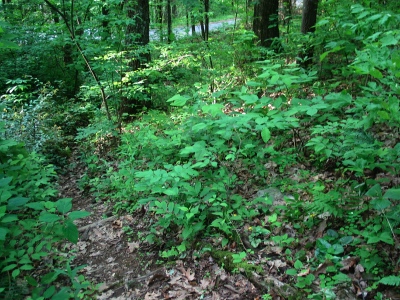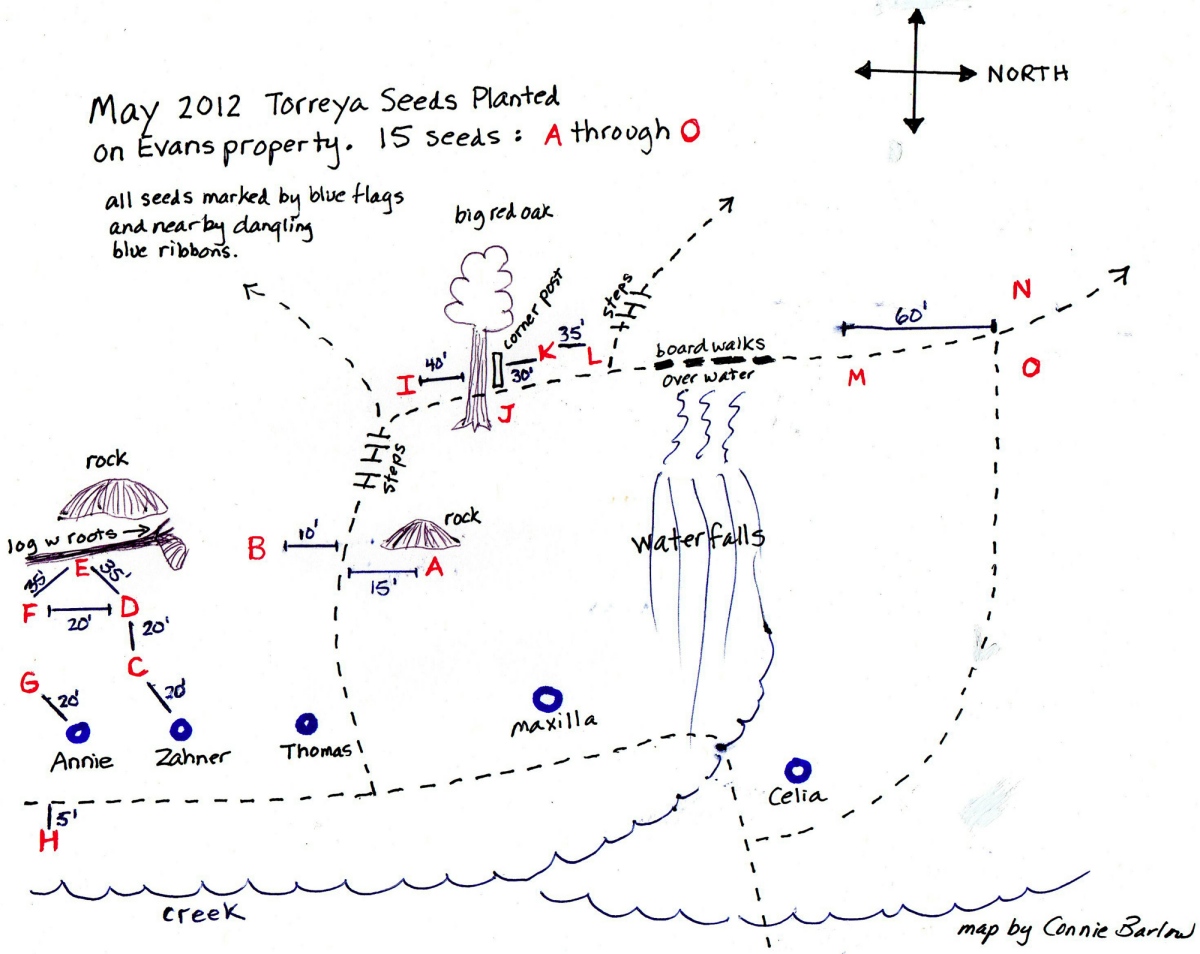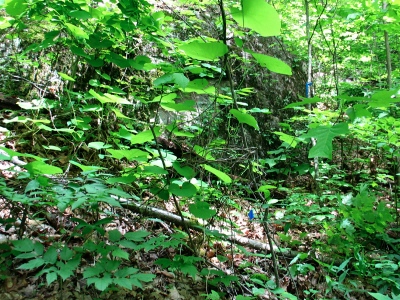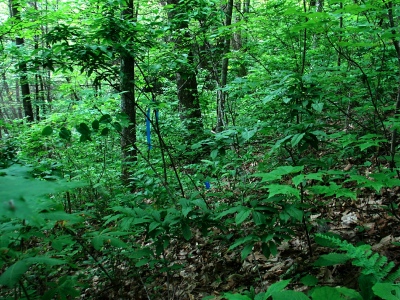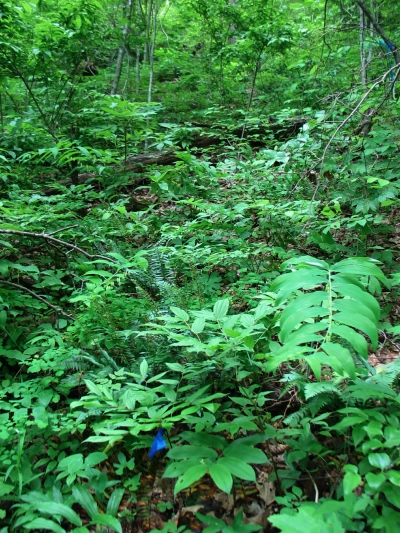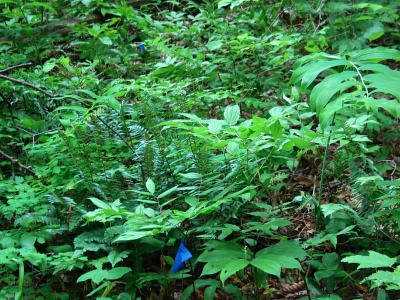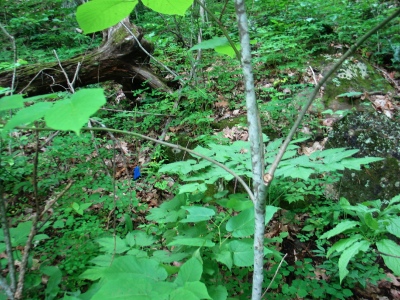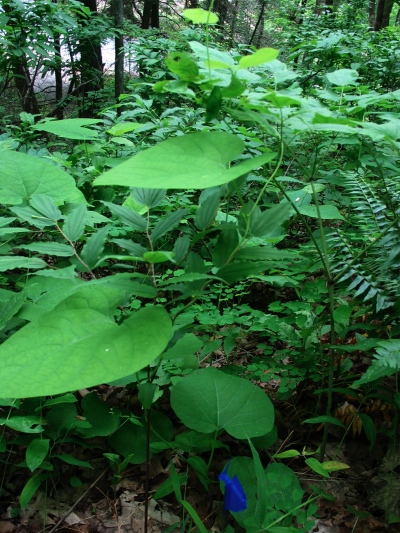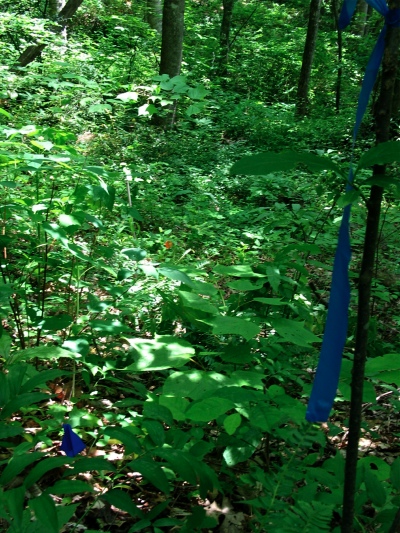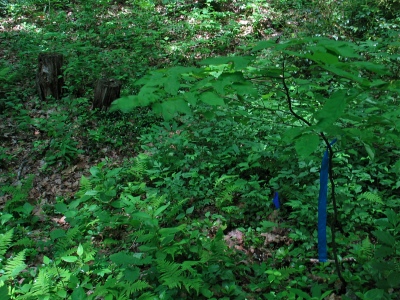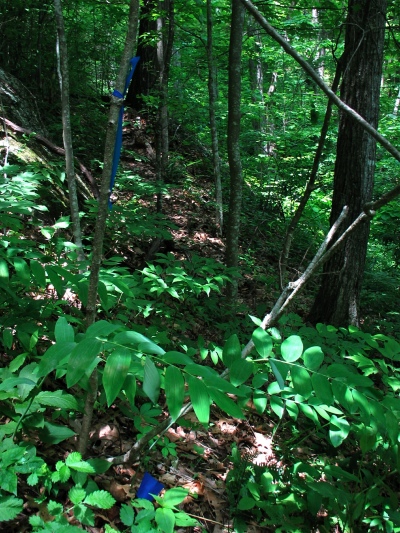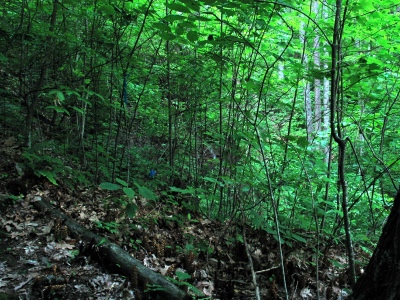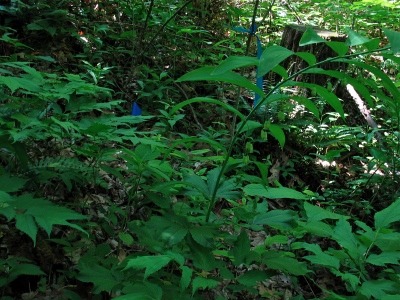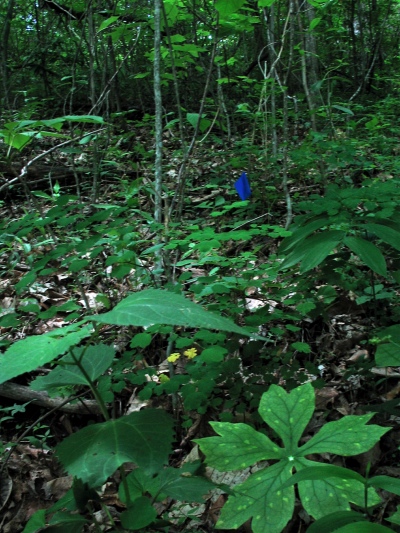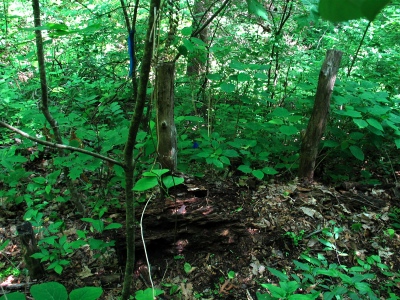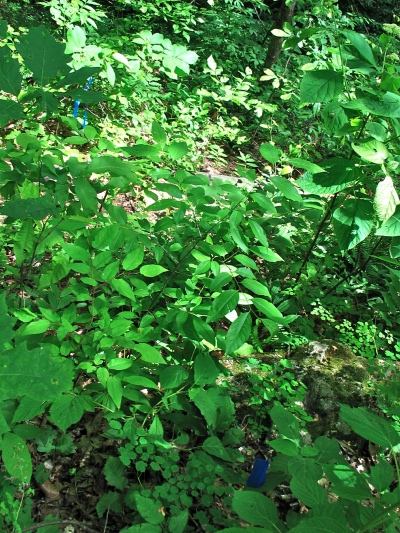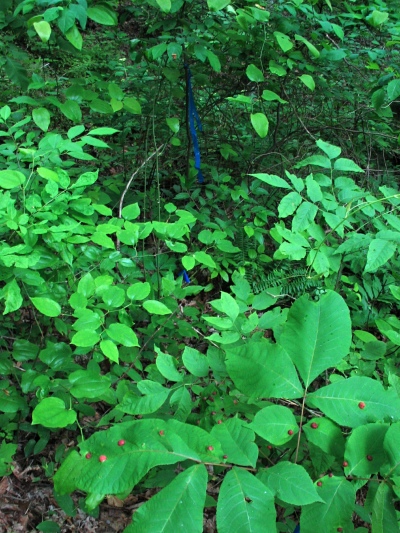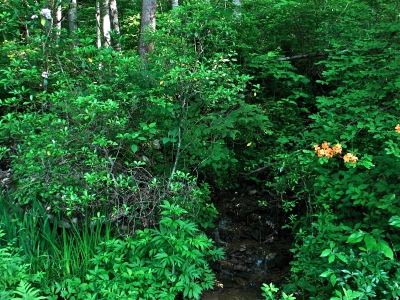
onto Evans Property, Waynesville, NC (15 seeds planted May 2012 by C. Barlow)
ABOVE: Connie Barlow received 20 seeds from the 2011 autumn harvest. Connie used the container at right, with all 20 seeds buried in the soil, while overwintering at 8,000 feet in Colorado. She subjected the container to numerous outdoor freeze (night) / thaw (bright sunlight) cycles — but she was careful to return the container to the refrigerator as soon as the evening plummeted to much below 32 degrees. The only seed that turned to mush, as a result, was the center bottom seed at left, which is clearly the runt of the bunch.
ABOVE LEFT: When Connie examined the seeds in March 2012, she discovered that the freeze/thaw experience had cracked four of them. But the inners seemed solid, and one was a lovely solid red.
ABOVE RIGHT: A number of the seeds she chose to scarify with a serrated knife, as an experiment to determine if that expedites germination. Her 2011 book, The Ghosts of Evolution, includes an experiment with Kentucky Coffee Seed (Gymnocladus), native to America, in which scarification greatly accelerates germination. Overall, tough-cased seeds that evolved with a large mammal or reptile disperser that swallowed the seed whole in order to benefit from the food-value of the surrounding hull tend to germinate the following spring only if artificial scarification mimics tooth action or digestive juices. Although squirrels are terrific dispersers of all species of Torreya today, it is possible that they also evolved with a large extinct tortoise as host (as the fleshy hull is palatable only to reptiles; the seeds pictured overwintered with their fleshy hulls removed.)
LEFT (May 19, 2012): Photographer (Connie) stands on the main pathway that leads between the Annie and Maxilla seedlings, looking upslope where the spur path upward begins. At this point, Wendell/Thomas Berry seedling would be to her left, and Maxilla seedling would be well to her right. Pictured is the spur path that heads directly upslope on the east-facing ravine above the little creek, and then curves to the right (north) to traverse over the forested bedrock above the falls. See MAP below. Six of the 15 seeds are planted off to the left of this path (southward), and the other 9 are to the right (northward).
RIGHT (May 19, 2012): Photographer (Connie) is standing on the same path pictured in the previous photo, but here she is looking back downhill from about 15 feet below where the path curves to the north to transit over the falls. Six seeds are various planted to the right of the path seen here. Connie Barlow deliberately chose microhabitats with moisture-loving plant species growing densely in place, as her experience the previous two days assessing the health of the 2008 planted seedlings suggested that Torreyas are by far healthiest in very moist (but well drained) locations, such as on this east-facing slope of the ravine. The paved road is visible in the farthest (downhill) distance in this photo.
LEFT (May 19, 2012) SEED A: Blue flag (lower, just right of center) marks where Seed A is planted. A blue ribbon encircles a 2" sapling Liriodendron in the distance, to aid finding this location. Associated plants: virginia creeper, poison ivy, trillium, pipevine, Smilax, dogwood, black kohosh, bloodroot, meadow rue. Photo was taken looking north from the 1st wooden step near the top of the uphill path. Notice the huge face of bedrock vertical in the immediate distance. [seed was naturally cracked during winter freeze/thaw; m]
RIGHT (May 19, 2012) SEED B: Blue flag (just below center) and dangling blue ribbon (tied onto a thin sourwood sapling) indicate the location. Associated plants: false solomon seal, Christmas ferns, trillium, jack-in-pulpit, meadow rue, Smilax (greenbriar). Photo was taken looking south from the 1st wooden step of the uphill path (so 180 degrees from the previous photo). [seed was naturally cracked during winter freeze/thaw; f]
LEFT (May 19, 2012) SEED C: Blue flag marking seed location is just 20 feet upslope from Bob Zahner seedling. Many moisture loving plants visible in the photo: false solomon seal, bloodroot, Christmas fern, meadow rue, hydrangia. [seed was naturally cracked during winter freeze/thaw; f]
RIGHT (May 19, 2012) SEED D: Flag for Seed C is center bottom, but at this angle you can also see the blue flag for Seed D in the distance: 1/3 inward from photo's left edge and 1/6 down from top edge. Same set of moisture-loving plants as surrounding Seed C. [seed was naturally cracked during winter freeze/thaw; m]
LEFT (May 19, 2012) SEED E: Location is uphill and southward of Seed D. It is just to the left of the first big exposed section of bedrock upslope form the "Annie" seedling. Currently (as seen in the photo) a rotting log is perched by its roots atop the outcrop. Micro-habitat includes these moisture-loving plants: hydrangia, meadow rue, black kohosh, Christmas fern, bloodroot. [seed has no cracks or artificial scarification; f]
RIGHT (May 19, 2012) SEED F: Location is 25 feet downslope (toward Seedling Annie) of Seed E location. The photograph is taken looking SE downhill, with road in distance. A downed log is close behind the photographer. Moisture loving plants are particularly dense here: pipevine, Christmas fern, deciduous ferns, meadow rue, bloodroot, false solomon seal, solomon seal, black kohosh. [seed has no cracks or artificial scarification; m]
LEFT (May 19, 2012) SEED G: Location is just 20 feet up the east-facing ravine slope from the seedling "Annie". (Annie's orange flag is visible as a small orange speck near the center of this photo.) Moisture loving plants in this location include hydrangia, Christmas fern, deciduous ferns, solomon seal, false solomon seal, bloodroot, greenbriar (Smilax). [seed was naturally cracked during winter freeze/thaw; f]
RIGHT (May 19, 2012) SEED H: This is the only seed planted near the creek itself. In this case, it is on a flat piece of ground where the creek temporarily levels out before going under the paved road. The two stumps in upper left of photo are good landmarks, with the path showing a bit of brown in front of them. The photo was taken with the creek to the photographer's back (6 feet away), and with "Annie" seedling just 25 upslope (and off the top of the picture border a ways). Plants surrounding the blue flag and the ribboned sampling include black kohosh, false solomon seal, jack-in-the-pulpit, trillium, and lots of deciduous ferns. [seed has no cracks or artificial scarification; m]
LEFT (May 19, 2012) SEED I: This seed (and all the rest that follow) are planted along the path that crosses over the top and back from the waterfalls. Seed I is the southernmost of them all. It occurs right where the upward path from the creek splits into a Y (one to the left, and another to the right). We shall follow the right path for all the rest of the seed plantings. Associated plants include black kohosh, nettle, jack-in-pulpit, Christmas fern, tall deciduous ferns, virginia creeper, poison ivy, Indian cucumber. Notice the exposed bedrock at the upper left of the photo. [seed has no cracks or artificial scarification; m]
RIGHT (May 19, 2012) SEED J: Blue flag is visible a little left and below the center of the photo, with a small cut stump visible as a dark splotch to its right. The path itself is trending uphill and north and is visible in lower left corner of photo, with a small log placed alongside to mark the edge. A glimpse of the big diameter trunk of a red oak variety shows in the right corner of the photo. To the left of the photographer (upslope side of the trail) are 2 property corner posts marked with bright turquoise ribbons (not shown in photo). Associated plants include: Christmas fern, Smilax, hydrangia, virginia creeper, false solomon seal, and lots of little American beech saplings that are easy to see in the photo. [seed has no cracks or artificial scarification; f]
LEFT (May 19, 2012) SEED K: Location is 5 feet off the uphill side of the path traversing over the top of and back from the waterfalls. The 18-inch diameter cut stump is a good landmark. The plant hanging down in the foreground is real solomon seal, surrounded by black kohosh. Other associated plants are hydrangia, Indian cucumber, jack-in-pulpit, trillium, Christmas fern, other deciduous ferns. [seed was artificially scarified with a knife to speed germination; m]
RIGHT (May 19, 2012) SEED L: The photographer is standing on the same path and looking uphill. Just beyond the right side of the photo is a spur trail that leads directly higher upslope (from the main path that pretty much traverses horizontally above the waterfalls and seeping bedrock). This spur trail is found just ten feet before we come to the first of several board walkways over the flowing water, as we continue to head northward on the horizontal path. Prominent in the foreground of the photo is a Mayapple leaf, almost surely planted by Maxilla Evans. Other associated plants are hydrangia, false solomon seal, violets, jack-in-ulpit, meadow rue, pipevine. There are lots of saplings visible just beyond the blue flag, as there is a big gap in the high canopy directly overhead, as tall trees regularly topple that try to grow on this moist steep slope. [seed has no cracks or artificial scarification; f]
LEFT (May 19, 2012) SEED M: This is the first of just 3 seeds planted beyond (northward of) the boardwalks that bridge over the running water sections cutting through the pathway (and that produce the waterfalls and seeping rock faces to the east). This seed is directly downslope of the path, easily located by the pair of posts. The blue flag is slightly visible in the very center of the photo, just to the right of the left-most post. the photographer is standing upslope, so the path is visible in the photo. This locale is home to lots of hydrangia, false solomon seal, Christmas fern, trillium, jack-in-pulpit. [seed has no cracks or artificial scarification; m]
RIGHT (May 19, 2012) SEED N: Seeds N and O are the final seeds planted in 2012 on the Evans property. They are paired just upslope and just downslope of where the spur path heads downward (eastward) toward the creek itself. Seed N blue flag is lower right of photo; its signal blue ribbon is tied to a sapling right next to the trail (upper left in photo). Look to the right of the blue flag and slightly "up" in the photo to see an exposed bit of boulder or bedrock. This seed was deliberately buried (about an inch, as with all seeds) close to this exposed rock because of Connie Barlow's experience with the California species of Torreya, which regularly grows on steep slopes amid rocks. Plants associated with Seed N include: hydrangia, false solomon seal, meadow rue, violets, Christmas fern. [seed was artificially scarified with a knife to speed germination; m]
LEFT (May 19, 2012) SEED O: Photographer is standing on the path and looking directly downslope. The blue ribbon dangles directly vertically over the blue flag in this photo. See a bit of the blue flag (by which the seed was planted) in the exact center of this photo. Associated plants include: hydrangia, false solomon seal, virginia creeper, Smilax, meadow rue, Christmas fern, Indian cucumber. [seed was artificially scarified with a knife to speed germination; m]
RIGHT (May 19, 2012): Ultimately, all the water gathers into a creek that goes under the paved road right beneath the feet of the photographer. (Flame azalea to the right.) The photographer is facing northward into the Evans property, and the creek begins sloping steeply upward. All the seeds were planted to the left (west) of this creek.
|
